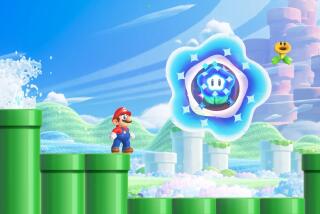‘Console Wars’ revisits the ‘90s clash between Sega and Nintendo
In the “console wars” of the early 1990s, I was in the trenches. Joystick in hand, I fought under the banner of Super Mario for Nintendo against the evil Sega and its not-so-super Sonic the Hedgehog.
At least, that was how it felt in elementary school. In Blake J. Harris’ new book, “Console Wars: Sega, Nintendo, and the Battle That Defined a Generation,” the wars are fought in the U.S. gaming market, and he pitches Sega as the plucky upstart taking on slow, incumbent Nintendo.
The tale is told largely from the perspective of Tom Kalinske, who revived Barbie at Mattel and was recruited from a Hawaiian sunlounger to lead Sega’s U.S. unit into battle. The dialogue-heavy narrative was reconstructed from some 200 interviews.
The book, published by Harper Collins, is already being turned into a movie. But, on paper at least, this is no “Moneyball.”
Where Michael Lewis’ tale illuminates both baseball and the power of data, “Console Wars” pays too much attention to the Sega C-suite and too little to the games and the kids who played them. It also fails to draw some useful parallels with today’s smartphone wars.
The book does offer some amusing trivia. “Donkey Kong” was created when Nintendo lost the videogaming rights to Popeye and had to come up with alternative characters in a rush. Mario was named after Nintendo’s office landlord.
Sonic the Hedgehog, meanwhile, was originally called Mr. Needlemouse. He sported a punky spiked collar, fangs and a busty girlfriend named Madonna before Sega’s U.S. arm persuaded Japanese counterparts to remove them.
Harris describes the now-classic blue hedgehog as an improbable amalgam of Teenage Mutant Ninja Turtles, Kurt Cobain, Michael Jordan and Bill Clinton: a ball of 1990s energy helping America shake off the Reagan and Bush years.
That may be a stretch but, as a “tiny underdog” who moved with “manic speed,” Sonic was more than just a mascot — he was totemic of Sega’s rebellious approach.
“If Nintendo represented control, Sega would represent freedom,” Harris writes of Kalinske’s strategy.
Nintendo is described much as Apple is today: obsessed with quality even at the expense of development speed, overbearing toward retailers and software developers, and highly litigious. Sega, like the free Android smartphone software Google pits against the iPhone, succeeded by offering friendlier terms to Nintendo’s partners.
Any Silicon Valley start-up CEO would admire Sega’s scrappy tactics, including pulling an all-nighter to undermine Nintendo’s grand unveiling of a price cut.
While Nintendo’s informal motto then was “the name of the game is the game,” Kalinske’s Sega was all pricing and marketing.
Sega’s MTV-friendly “Next Level” ad campaign and simultaneous global launch of the 1992 sequel to Sonic succeeded for a while, as Nintendo’s U.S. market share plunged from 60% in 1992 to 37% a year later.
But a $100-million marketing campaign did not prevent Sega’s follow-up to the Genesis console from flopping a few years later. Sega focused on gimmicky add-ons, while the “tortoise” Nintendo reliably produced high-quality games such as “Donkey Kong Country.”
Sega’s focus on glitzy marketing recalls Samsung, whose “Next Big Thing” tagline propelled its Galaxy smartphones ahead of Apple’s.
But just as Harris says games developers struggled with “too many different systems” at Sega, Apple’s best weapon in winning over app makers is still the simplicity of its app store, in contrast to the fragmented world of Android handsets.
Today, your choice of smartphone enlists you in one of two clashing tribes. But as the Sony PlayStation’s eventual success at the expense of Sega and Nintendo shows, new fronts can open at any time in the technology war zone.
The writer is a San Francisco tech reporter for the Financial Times of London, in which this review first appeared.






